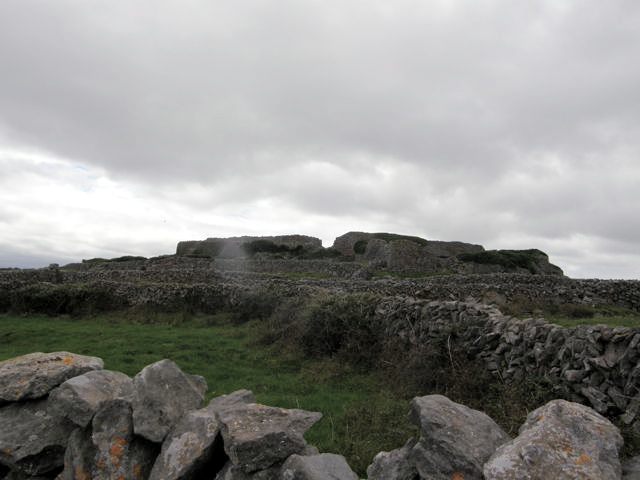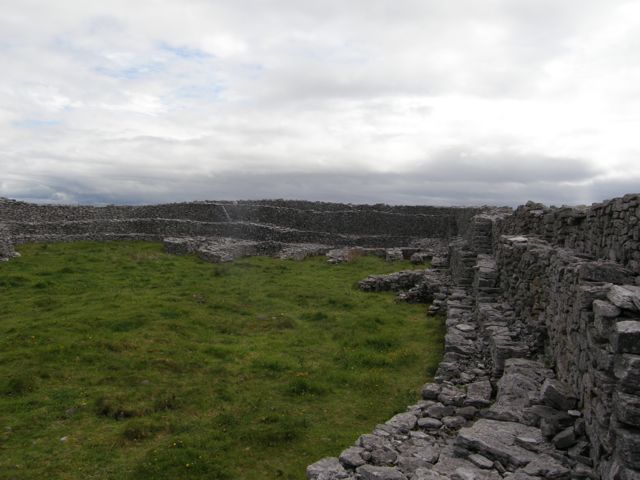One of the places I visited with my daughter Caitlin and her friend Jeff was the Caherconnell Ring Fort in the Burren of County Clare. A ring fort is an early medieval farmstead enclosed by one or more roughly circular dry stone walls or earthen banks. Although called “forts”, these dwelling-places are believed to have not been designed for defense. Rather, the role of the walls was to give shelter and security to the family, their livestock, and their possessions. The scale and complexity of the banks or walls may also have served as an indicator of the occupier´s status.
Caherconnell, according to an archeologist quoted on its website, “is a large and perfect fort 140-145 feet in external diameter, nearly circular in plan. It is 12 feet thick and from 6-14 feet high. The masonry consists of large blocks many 3 feet long and 2 ft. 6 in. high. The inner face is almost perfect.” It is a large and impressive place believed to have been originally built circa 400-600 AD and inhabited (and possibly rebuilt) up to the 15th or 16th Century.
The interior of the fort was divided by a stone wall and there are foundations of buildings which may have been dwellings, workshops, livestock enclosures, or for other purposes.
Although Caherconnell and the other ring forts of the Burren (it is estimated there may be as many as 450 in that area) date from the middle of the first millennium AD, this style of stone enclosure is quite ancient in Ireland. A few years ago, my wife Evelyn and I visited Dún Aonghasa on Inis Mór (the largest of the Aran Islands), and a couple of years after that, with a class from Acadamh na hOllscolaíochta Gaeilge, I visited Inis Meán (the middle island) where one finds Dún Chonchúir. These forts are believed to date from pre-Christian times, perhaps the 2nd Century BC.
Notice that the names of these earlier structures include the term dún which means “fort” and was sometimes used to describe a castle. The later structures, the ring forts of the Burren, are named with the term “caher”, an Anglicized form of the Irish word cathair, which seems to have originally meant “a dwelling place” and in modern Irish means “city”. Both are terms for shelter and protection. St. Augustine used the image of a city as a metaphor for heaven in his treatise The City of God. In an earlier post, Translating Hymns (Part 3) (22 June 2011), I posted a hymn from Dánta Dé entitled An Dún Áluinn (“The Beauteous Fort”) in which the 13th Century Irish bard Donnchadh Mór O Dálaigh (who may also have been Abbot of Boyle Abbey) used the image of a dún as a metaphor for heaven. Both, of course, are drawing on the imagery of the Book of Revelation in which John of Patmos received a vision of heaven as a walled city: “And I John saw the holy city, New Jerusalem, coming down from God out of heaven, prepared as a bride adorned for her husband.” (Revelation 21:2)
John continues:
I heard a loud voice from the throne saying, “See, the home of God is among mortals. He will dwell with them; they will be his peoples, and God himself will be with them; he will wipe every tear from their eyes. Death will be no more; mourning and crying and pain will be no more, for the first things have passed away.” (Revelation 21:3-4)
Again, shelter and protection are the dominant themes, just as they were the purpose of the circular dúns and cathairs of Ireland.
Earlier this year Christian leaders in the United States, including the Presiding Bishop of my own tradition, the Episcopal Church, issued a statement entitled A Circle of Protection. In it, they remind our political leaders that “budgets are moral documents, and how we reduce future deficits are historic and defining moral choices.” As leaders of and spokespersons for the larger Christian community, they “urge Congress and the administration to give moral priority to programs that protect the life and dignity of poor and vulnerable people in these difficult times, our broken economy, and our wounded world.” The statement includes these key principles:
- The nation needs to substantially reduce future deficits, but not at the expense of hungry and poor people.
- Funding focused on reducing poverty should not be cut. It should be made as effective as possible, but not cut.
- We urge our leaders to protect and improve poverty-focused development and humanitarian assistance to promote a better, safer world.
- National leaders must review and consider tax revenues, military spending, and entitlements in the search for ways to share sacrifice and cut deficits.
- A fundamental task is to create jobs and spur economic growth. Decent jobs at decent wages are the best path out of poverty, and restoring growth is a powerful way to reduce deficits.
- The budget debate has a central moral dimension. Christians are asking how we protect “the least of these.” “What would Jesus cut?” “How do we share sacrifice?”
- As believers, we turn to God with prayer and fasting, to ask for guidance as our nation makes decisions about our priorities as a people.
- God continues to shower our nation and the world with blessings. As Christians, we are rooted in the love of God in Jesus Christ. Our task is to share these blessings with love and justice and with a special priority for those who are poor.
Among the morning hymns of Dánta Dé is a short prayer for shelter and protection. In the spirit of the Circle of Protection statement, I offer it here on behalf of the poor and hungry. It is set out below in the original Irish, in the translation by Úna ní Ógáin, and in my own translation:
Rí na naomh dár ndíon gach lae
Ar shaoigheadaibh daora an dhiabhail
Noch bhís go gear ar tí gach naoimh
De chlainn bhoicht Éabha riamh
Mo mhile lean-sa claoidhte faon
Faoi gach éiliomh dian,
Acht tríot-sa, a aon-mhic dhilis dé,
Go dtigeam-na saor ó phian
Ms. ní Ógáin’s translation:
The King of the saints be our shelter each day,
Against the dangerous darts of the devil,
Who is ever keenly pursuing each saint
Of the poor children of Eve
My thousand sorrows, worn, exhausted,
Because of each hard temptation;
But through Thee, o dear Only Son of God,
May we come safe from pain.
My own translation:
King of the saints, our shelter every day
Against the furious arrows of the devil
Who is [constantly] sharply pursuing each saint
Of the poor children of Eve
Our thousand sorrows, worn down, helpless
Because of each severe corruption
But through you, God’s only true Son,
May we come free of pain.
Just as the dúns and cathairs of ancient Ireland provided circles of protection for those who lived within them, the Christian community is to be a circle of protection. The difference between the church and the dúns and cathairs is that the circle of protection drawn by the Christian is to be inclusive of all, those without as well as those within. Archbishop William Temple, who was Archbishop of Canterbury during the Second World War, once wrote these words: “The Church is the only society that exists for the benefit of those who are not its members.” And I am reminded of the poem Outwitted by American poet Edwin Markham:
He drew a circle that shut me out —
Heretic, rebel, a thing to flout.
But Love and I had the wit to win:
We drew a circle that took him in.











Leave a Reply